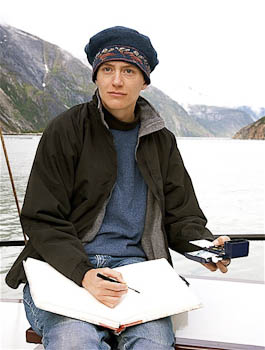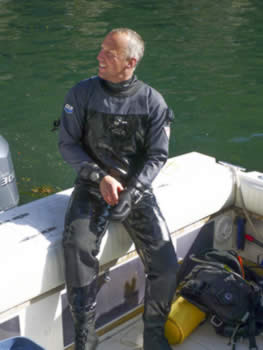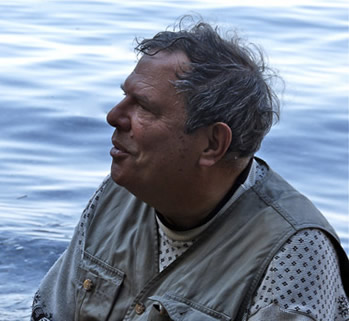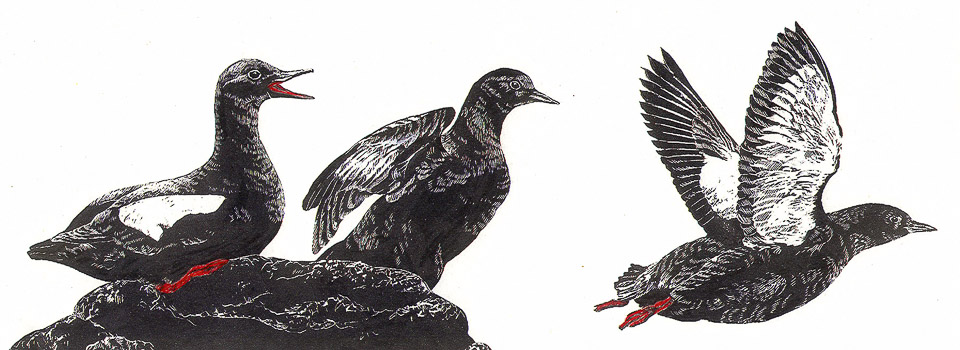| CLOUD RIDGE STAFF & GUEST LEADERS
 Audrey Benedict is the Founder and Director of Cloud Ridge Naturalists. Trained in geology and biology, her 40-year love affair with high mountains and the global ocean realm have taken her from the Arctic to the Antarctic, as well as up and down the North and South American Cordillera. Audrey is the author of the definitive The Naturalist’s Guide to the Southern Rockies: Southern Wyoming, Colorado, and Northern New Mexico and Valley of the Dunes: Great Sand Dunes National Park and Preserve, the latter with photographers Bob Rozinski and Wendy Shattil, and is currently working on a book on seabirds as conservation ambassadors for the global ocean. She serves on the SeaDoc Society’s Board of Directors and is excited about being actively involved in ocean conservation. Audrey divides her time between her Colorado mountain home near the Indian Peaks Wilderness Area and her tiny Frost Island retreat in the San Juan Islands. Audrey Benedict is the Founder and Director of Cloud Ridge Naturalists. Trained in geology and biology, her 40-year love affair with high mountains and the global ocean realm have taken her from the Arctic to the Antarctic, as well as up and down the North and South American Cordillera. Audrey is the author of the definitive The Naturalist’s Guide to the Southern Rockies: Southern Wyoming, Colorado, and Northern New Mexico and Valley of the Dunes: Great Sand Dunes National Park and Preserve, the latter with photographers Bob Rozinski and Wendy Shattil, and is currently working on a book on seabirds as conservation ambassadors for the global ocean. She serves on the SeaDoc Society’s Board of Directors and is excited about being actively involved in ocean conservation. Audrey divides her time between her Colorado mountain home near the Indian Peaks Wilderness Area and her tiny Frost Island retreat in the San Juan Islands.
 Dr. Geoff Hammerson is Senior Research Zoologist for NatureServe and lives in Port Townsend, WA. Geoff is the lead biologist on Cloud Ridge’s naturalist team, helping design and guide our field discovery program around the world. He is the author of the definitive field guide Amphibians and Reptiles in Colorado, as well as Connecticut Wildlife. Geoff and his river colleagues are currently completing their muchanticipated book on the natural history of Colorado’s Yampa River. A superb zoologist, Geoff is always adding new dimensions to his natural history expertise. He’s a popular instructor wherever he goes, teaching field biology and ecology at Wesleyan University and other institutions. Geoff is best known for his remarkable talent for coaxing the most reluctant animal to share its secrets with an appreciative audience. Dr. Geoff Hammerson is Senior Research Zoologist for NatureServe and lives in Port Townsend, WA. Geoff is the lead biologist on Cloud Ridge’s naturalist team, helping design and guide our field discovery program around the world. He is the author of the definitive field guide Amphibians and Reptiles in Colorado, as well as Connecticut Wildlife. Geoff and his river colleagues are currently completing their muchanticipated book on the natural history of Colorado’s Yampa River. A superb zoologist, Geoff is always adding new dimensions to his natural history expertise. He’s a popular instructor wherever he goes, teaching field biology and ecology at Wesleyan University and other institutions. Geoff is best known for his remarkable talent for coaxing the most reluctant animal to share its secrets with an appreciative audience.
 Bob Rozinski & Wendy Shattil are the rarest of species—full-time professional nature photographers. They’ve worked individually and as a team for more than 30 years and are known world-wide for their award-winning images and reputations as environmental photographers of endangered species and at-risk ecosystems throughout North America. Fellows of the International League of Conservation Photographers, Bob and Wendy have produced twelve books, and their images have appeared in National Wildlife, Audubon, Nature Conservancy, BBC Wildlife, Nature’s Best, National Geographic publications, and many others. Constantly working to create new ways of illuminating key conservation issues, Bob and Wendy are superb teachers and always generous in sharing their expertise. To see more of their photographic work visit their website: www.dancingpelican.com Bob Rozinski & Wendy Shattil are the rarest of species—full-time professional nature photographers. They’ve worked individually and as a team for more than 30 years and are known world-wide for their award-winning images and reputations as environmental photographers of endangered species and at-risk ecosystems throughout North America. Fellows of the International League of Conservation Photographers, Bob and Wendy have produced twelve books, and their images have appeared in National Wildlife, Audubon, Nature Conservancy, BBC Wildlife, Nature’s Best, National Geographic publications, and many others. Constantly working to create new ways of illuminating key conservation issues, Bob and Wendy are superb teachers and always generous in sharing their expertise. To see more of their photographic work visit their website: www.dancingpelican.com
 Jennifer Hahn is a naturalist, a writer, illustrator, teacher, wild harvester, and coastal traveler. She has 30 years of wilderness travel experience, including guiding natural history trips by sea kayak in the San Juan Islands for 22 years, solo-kayaking from Southeast Alaska to Washington, and has spent many seasons guiding in Southeast Alaska. She is author of the award-winning Spirited Waters: Soloing South Through the Inside Passage, and Pacific Feast: A Cook’s Guide to West Coast Foraging and Cuisine. Jenny teaches courses in wild foraging, indigenous plant uses, and seaweed biology as an adjunct professor at Western Washington University’s Fairhaven College and for other venues. The expertise, poetic voice, and infectious enthusiasm Jenny brings to her natural history teaching is a rare gift. To learn more about Jenny’s books and wild harvesting visit: www.pacificfeast.com Jennifer Hahn is a naturalist, a writer, illustrator, teacher, wild harvester, and coastal traveler. She has 30 years of wilderness travel experience, including guiding natural history trips by sea kayak in the San Juan Islands for 22 years, solo-kayaking from Southeast Alaska to Washington, and has spent many seasons guiding in Southeast Alaska. She is author of the award-winning Spirited Waters: Soloing South Through the Inside Passage, and Pacific Feast: A Cook’s Guide to West Coast Foraging and Cuisine. Jenny teaches courses in wild foraging, indigenous plant uses, and seaweed biology as an adjunct professor at Western Washington University’s Fairhaven College and for other venues. The expertise, poetic voice, and infectious enthusiasm Jenny brings to her natural history teaching is a rare gift. To learn more about Jenny’s books and wild harvesting visit: www.pacificfeast.com
 Sarah Drummond is a naturalist and artist who grew up traveling with Cloud Ridge and is now a member of our naturalist staff. She received her B.A. from Maine’s College of the Atlantic, where her studies emphasized ecology, island ecosystems and art; her M.A. is from Arizona’s Prescott College. Research for her thesis on the role and impact of artists who accompanied major exploring expeditions prior to the invention of photography began during a Watson Foundation fellowship, and is the focus of a book she’s currently working on. Sarah also creates books for children, including Raven and the Red Ball, which is awaiting publication. Sarah is an adjunct faculty member at College of the Atlantic and teaches both art and natural history in a variety of venues. She spends her summers as a naturalist/kayak guide in Southeast Alaska aboard the M/V Catalyst. As an artist, Sarah’s work celebrates the beauty and diversity of the natural world and she prides herself on working directly from life, in the field, whenever possible. To see more of her artwork visit: www.sarahdrummondart.com Sarah Drummond is a naturalist and artist who grew up traveling with Cloud Ridge and is now a member of our naturalist staff. She received her B.A. from Maine’s College of the Atlantic, where her studies emphasized ecology, island ecosystems and art; her M.A. is from Arizona’s Prescott College. Research for her thesis on the role and impact of artists who accompanied major exploring expeditions prior to the invention of photography began during a Watson Foundation fellowship, and is the focus of a book she’s currently working on. Sarah also creates books for children, including Raven and the Red Ball, which is awaiting publication. Sarah is an adjunct faculty member at College of the Atlantic and teaches both art and natural history in a variety of venues. She spends her summers as a naturalist/kayak guide in Southeast Alaska aboard the M/V Catalyst. As an artist, Sarah’s work celebrates the beauty and diversity of the natural world and she prides herself on working directly from life, in the field, whenever possible. To see more of her artwork visit: www.sarahdrummondart.com
 Marilyn Hailbronner’s drawings—rendered in pen and ink and color wash—grace Cloud Ridge’s brochure and website. She serves as a member of Cloud Ridge’s naturalist staff and is our advisor on wilderness travel and medical issues. Summers will find Marilyn working aboard the M/V Sea Wolf as a naturalist/kayak guide in Glacier Bay. Her work as a naturalist artist is a reflection of her love for the natural world and her passion for conservation, which takes her to wilderness areas around the world. Among many projects, she is currently working on a children’s book on the Magellanic penguins of Argentina’s Peninsula Valdés. To see more of Marilyn’s artwork visit her website: www.wildinkwell.com Marilyn Hailbronner’s drawings—rendered in pen and ink and color wash—grace Cloud Ridge’s brochure and website. She serves as a member of Cloud Ridge’s naturalist staff and is our advisor on wilderness travel and medical issues. Summers will find Marilyn working aboard the M/V Sea Wolf as a naturalist/kayak guide in Glacier Bay. Her work as a naturalist artist is a reflection of her love for the natural world and her passion for conservation, which takes her to wilderness areas around the world. Among many projects, she is currently working on a children’s book on the Magellanic penguins of Argentina’s Peninsula Valdés. To see more of Marilyn’s artwork visit her website: www.wildinkwell.com
 Dr. Joe Gaydos is a wildlife veterinarian and Chief Scientist for the SeaDoc Society, and lives on Orcas Island with his family. The SeaDoc Society, a science-based marine conservation program of the UC Davis Veterinary Medicine/ Wildlife Health Center, funds and conducts research and uses this information to educate people about our marine resources and to help improve management and policy decisions regarding the stewardship of those resources. Joe has focused SeaDoc’s efforts on the ecosystem-level challenges facing the Salish Sea for more than a decade. He’s published extensively on shared human and marine wildlife health issues for species such as harbor seals, river otters, and killer whales. Joe has also testified on the current state of marine science for numerous commissions and governmental agencies. He has an incredible knack for connecting people to the magic and vulnerability of the marine world, whether through his keynote addresses, lectures, his field teaching, or by conducting one of his infamous “virtual dives” that opens a window on the marine world never to be forgotten. Dr. Joe Gaydos is a wildlife veterinarian and Chief Scientist for the SeaDoc Society, and lives on Orcas Island with his family. The SeaDoc Society, a science-based marine conservation program of the UC Davis Veterinary Medicine/ Wildlife Health Center, funds and conducts research and uses this information to educate people about our marine resources and to help improve management and policy decisions regarding the stewardship of those resources. Joe has focused SeaDoc’s efforts on the ecosystem-level challenges facing the Salish Sea for more than a decade. He’s published extensively on shared human and marine wildlife health issues for species such as harbor seals, river otters, and killer whales. Joe has also testified on the current state of marine science for numerous commissions and governmental agencies. He has an incredible knack for connecting people to the magic and vulnerability of the marine world, whether through his keynote addresses, lectures, his field teaching, or by conducting one of his infamous “virtual dives” that opens a window on the marine world never to be forgotten.
 Russel Barsh spent his boyhood on Long Island Sound as a devoted beachcomber and fossil-hunter. As a doctoral student in paleontology at Harvard, Russel was privileged to study under the late Dr. Loren Eiseley and Dr. Stephen Jay Gould—each a role model in multidisciplinary science. His friendships with Native Americans opened his eyes to new science challenges, convincing him get a law degree and to defend the environmental integrity of traditional cultures. Russel taught at the University of Washington and helped develop its American Indian Studies Center. He then served as an advisor to United Nations agencies on indigenous and tribal peoples living in sensitive ecosystems, establishing the UN’s Permanent Forum on Indigenous Issues. Russel co-founded Kwiáht (Center for the Historical Ecology of the Salish Sea) at the urging of his longtime friend and Samish Tribal leader, the late Ken Hanson. “Kwiáht” means “a clean place” in the Native American language of the Central Sound—a one-word mission statement embracing the use of science to inform and promote good stewardship of cultural and biological resources in the San Juan Archipelago. Now based on Lopez Island, he and his staff scientists, student interns, and dedicated volunteers manage the San Juan Islands Marine Health Monitoring Network and the Islands Plant Diversity Bank, as well as school programs meant to inspire young stewards. Russel Barsh spent his boyhood on Long Island Sound as a devoted beachcomber and fossil-hunter. As a doctoral student in paleontology at Harvard, Russel was privileged to study under the late Dr. Loren Eiseley and Dr. Stephen Jay Gould—each a role model in multidisciplinary science. His friendships with Native Americans opened his eyes to new science challenges, convincing him get a law degree and to defend the environmental integrity of traditional cultures. Russel taught at the University of Washington and helped develop its American Indian Studies Center. He then served as an advisor to United Nations agencies on indigenous and tribal peoples living in sensitive ecosystems, establishing the UN’s Permanent Forum on Indigenous Issues. Russel co-founded Kwiáht (Center for the Historical Ecology of the Salish Sea) at the urging of his longtime friend and Samish Tribal leader, the late Ken Hanson. “Kwiáht” means “a clean place” in the Native American language of the Central Sound—a one-word mission statement embracing the use of science to inform and promote good stewardship of cultural and biological resources in the San Juan Archipelago. Now based on Lopez Island, he and his staff scientists, student interns, and dedicated volunteers manage the San Juan Islands Marine Health Monitoring Network and the Islands Plant Diversity Bank, as well as school programs meant to inspire young stewards.
 Madrona Murphy is a native Lopezian, whose love for the San Juan Islands eventually brought her back to Lopez Island after she earned a degree in botany and political science from Oregon’s Reed College. With a special interest in plant genetics, she worked as a technician at the University of Washington’s Center for Cell Dynamics at Friday Harbor Laboratories before establishing and managing Kwiáht’s genotyping laboratory. Madrona capitalizes on her knowledge of how indigenous peoples used the land and shaped the ecosystems that we see today to inform her botanical surveys and her design of re-vegetation plans for restoration projects. Her interest in population genetics also includes studies of local populations of salmon, coastal cutthroat trout, camas, small mammals, and the rare Island Marble butterfly. Madrona Murphy is a native Lopezian, whose love for the San Juan Islands eventually brought her back to Lopez Island after she earned a degree in botany and political science from Oregon’s Reed College. With a special interest in plant genetics, she worked as a technician at the University of Washington’s Center for Cell Dynamics at Friday Harbor Laboratories before establishing and managing Kwiáht’s genotyping laboratory. Madrona capitalizes on her knowledge of how indigenous peoples used the land and shaped the ecosystems that we see today to inform her botanical surveys and her design of re-vegetation plans for restoration projects. Her interest in population genetics also includes studies of local populations of salmon, coastal cutthroat trout, camas, small mammals, and the rare Island Marble butterfly.
|
